This article was co-authored by Mayami Oyanagi. Mayami Oyanagi is a Physical Therapist and the owner of PT STOP Physical Therapy & Wellness, an individualized physical therapy practice in Los Angeles, California. With over 14 years of experience, Mayami specializes in orthopedic injuries, manual therapy, and sports medicine. She holds an MS in Physical Therapy from the University of Hartford. Mayami is also a board certified Orthopedic Clinical Specialist. She treats the root cause of her client’s problems by utilizing biomechanical assessments.
There are 12 references cited in this article, which can be found at the bottom of the page.
This article has been viewed 156,146 times.
A good pillow is one element of a good night's sleep no matter if you are traveling or in your own bed. If you have chronic head and neck pain, though, it might be difficult with a conventional pillow. Neck pillows are designed specifically to support your head and neck in a natural and neutral position.[1] A good neck pillow can also improve your quality of sleep. You can use a neck pillow and get a good night's sleep by optimizing your travel, finding the right product for you and sleeping on your choice for a week.
Steps
Optimizing Your Travel Experience with a Neck Pillow
-
1Upgrade your current travel neck pillow. Gone are the days of minimally comfortable, plastic blow up travel neck pillows. You can now get very comfortable travel neck pillows that can help you sleep in even the most crowded spaces. Take the opportunity to upgrade your current neck pillow to a cushy version that can enhance your travel experience.[2]
- Consider your specific needs. Do you have neck or back pain? An option that holds your head upright may be best for you. Do you want to be able to move around and not disrupt your fellow passengers? Consider a traditional donut-shaped pillow filled with gel.
- Make sure to explore your different options. Getting suggestions from fellow travelers or reading product reviews may give you more insight into specific models.
- Think about the pillow's portability. If you like to travel light or without any awkwardly shaped items that you have to strap to your suitcase, look at the weight and size of each pillow option.
-
2Choose your seat early for the best space. Seat location can make a big difference in how comfortable you are—and how you can best use your upgraded pillow. If you are able, choose your seat as soon as you can so that you're not locked out of a prime spot for sleeping.[3]
- Select or request a window seat if you can. You may even want to consider paying a bit extra for a window seat to increase your comfort. Window seats have a couple of benefits: they give something on which you can lean and help you avoid people crawling over you to get to the bathroom or for a walk. You can also control the window shade, which may help you sleep better.
- Sit near the front of the plane if possible. There is generally more noise at the back of the plane because of the place of the engines. However, you may be more likely to get a full row or two seats to yourself towards the back of the plane. This could make up for the extra noise. Ask an attendant at check-in what's available and change seats to better options if you can.
- Avoid bulkheads and exit rows. Although you'll have extra legroom, you may not be able to recline the seats or move the armrest.
Advertisement -
3Inflate your pillow. Depending on what option you purchased, you probably need to blow up your neck pillow. Getting the right amount of air into the pillow can promote your ability to sleep as well as your comfort.
- Take your pillow of its case and look for the inflation valve. Start to either pump or blow air into the pillow until it is full. Lay back on the pillow to see if it is comfortable.
- Open the valve and slowly let out air until it reaches a level with which you're comfortable. If you want a firmer pillow, add more air.
-
4Recline your seat. Sitting up straight can cause back pain and many people find it difficult to fall asleep in this position. Reclining your seat as far back as you are able will take pressure off of your lower back. It may also contribute to more optimal use of your neck pillow.[4]
- Be considerate of the person sitting behind you. For example, if you are on a plane and it's mealtime, only recline your seat a bit or wait until the meal is over. You can always adjust your seat as the situation allows.
-
5Flip your neck pillow. Some may find sleeping with a bulge behind their heads slightly uncomfortable. Your head may also keep falling forward. In either case, think about flipping your neck pillow in the opposite direction to protect your head while keeping your neck aligned.[5]
-
6Direct pillow stuffing for extra comfort. Many neck pillows have some type of stuffing such as beads or gel. Move the stuffing over to your most preferred side of the pillow for added comfort. Tie off the end with a hair tie or another item that will keep the stuffing from shifting.[6]
-
7Lie back on your pillow. Once you've got your seat reclined, it's time to put your pillow to use. Lie back and close your eyes. If you feel uncomfortable, make adjustments to the pillow's air until you are able to lie back and relax.[7]
- Try wedging your pillow in the small space between seats or up against the window.
Sleeping on Your Neck Pillow in Bed
-
1Slide your neck onto the pillow. When you're ready to lie down in bed, place your neck in or on your neck pillow. Do this in the spot you want to sleep so that you don't have to move out of the proper position, which may increase your risk of neck pain.
- Make sure that the back of your shoulder(s) and your head are touching the surface on which you're lying.[8]
-
2Check your alignment. Once you've put your head down on the neck pillow, it's important to see if you are in the proper alignment. This can ensure that you protect your neck and get the most comfortable night's sleep possible.[9]
- Make sure your neck pillow is supporting you without your head tilting forward or backward if you are a back sleeper.
- See if your neck is supported and your nose in line with the center of your body if you are a side sleeper.
- Keep in mind that both of these will work if you are a combination sleeper.
-
3
-
4Give yourself time to settle. It takes your neck about 10 to 15 minutes to relax and settle onto your pillow. Before your start thrashing around because you're uncomfortable, stay in one position to see if that's best for you. If not, move into a different position until you find one in which your neck can relax.[12]
- Remember to give yourself one week of sleeping on a neck pillow to figure out if it is the right one for you. If the pillow still isn't comfortable after a week, consider returning it and/ or getting another option.
-
5Start with the lobes facing downward. Most neck pillows have lobes to help keep your neck properly aligned during the night. If you're new to sleeping with a neck pillow, you may find it difficult to sleep on the side with the lobes. For the first few weeks, consider sleeping with the lobes facing downward to help your head and neck adapt to the need sleeping position.
- Recognize it may take a bit of trial and error to see where on the pillow is most comfortable with the lobes facing downward. Go with whatever provides the most support and is the most comfortable.
-
6Turn over the pillow. After 1-3 weeks of sleeping with the lobes facing downward, turn over the pillow to the lobed side. This allows the pillow to return to its natural shape and can ensure that you get continued excellent neck support.
- Consider turning over your any pillow you have every few weeks.
Choosing the Right Neck Pillow for You
-
1Talk to a medical professional. If you have chronic neck pain and are seeing a medical professional about it, ask what type of neck pillow is optimal for your specific needs. This can help you narrow down the list of potential choices.[13]
- Make sure to give your doctor any potentially relevant information about the way you sleep such as position, snoring or sleep apnea, or even if you sweat a lot. Your doctor may know of specific brands that can accommodate all of your needs.
- Ask for a couple of different suggestions from your doctor in case you don't like one of the pillows. Let your doctor know if you are using the pillow for your bed or for travel, which may influence his or her suggestions.
-
2Figure out your dominant sleeping position. Your dominant sleeping position is the position into which you settle and is likely your favorite way to sleep. Establishing your dominant sleeping position can help you determine the best type of pillow to get you comfortably through the night or a long flight.[14] The following are the types of sleeping position you may be:
-
3Look for the right firmness and height. Each dominant sleeping position has different needs in order to maintain alignment and comfort. When buying your pillow, make sure you look at models that are the appropriate firmness and height for your sleep position. The following options are best for each dominant sleeping position type:[17]
- Side sleepers: a firm or extra firm pillow that is 10 centimeters (4 inches) high
- Back sleepers: a medium-firm pillow that is a medium loft, which is the pillow's height when it's lying flat on the bed
- Stomach sleepers: a thin and soft, scrunch-able pillow
- Combination sleepers: a pillow with softer and firmer sections that is higher on the sides and lower on the center for when you change positions
- Travelers: pillows that provide maximum comfort for your specific needs and how you sleep. This includes neck support and ability to shift in your seat.[18]
-
4Take into account the pillow material. Just as the firmness and height are important to your neck pillow selection, the material can also make a difference. Materials like memory foam or down may be better for certain positions over others. Sleepers may want to consider the following materials for a more comfortable night's sleep:[19]
- Side sleepers: contoured memory foam or latex foam
- Back sleepers: down alternative, memory foam, latex foam
- Stomach sleepers: down, feathers, down alternative, polyester, or thin foam latex
- Combination sleepers: buckwheat hulls and multiple-material pillows
- Travelers: memory foam, gel, plush fabric[20]
-
5Consider other factors. For as simple as sleeping seems, it can actually be slightly complex. Factors such as your mattress and size as well as how long you're traveling can also have an impact on your pillow choice. In turn, this may affect the type of neck pillow you use.
- Think about how soft your mattress is. If it is on the softer side, it may cause your body to settle more in relation to your pillow. This means you should get a lower loft, or height, pillow.
- Consider your body temperature. Do you get very hot at night? If so, you may want to consider a gel foam cooling pillow or a buckwheat hull version.
- Keep your body frame in mind. If you have a smaller frame, see if you can get a smaller neck pillow to fit your body.
- Think about how you normally sleep when you travel. Do you shift positions frequently and need a little bit more space? You may want a larger travel pillow that allows you to fully relax in your space. Be aware that these options that let you sprawl out and sleep may irritate fellow travelers.[21]
- Ensure the pillow is allergy tested and washable so that dust mites don't build up on the surface over time.[22] This can not only cause allergic reactions but actually alter the weight and shape of your neck pillow.[23]
-
6Try out different pillows. Every person's body is different. Part of having the right pillow is finding one that fits you and your body best. Trying out different options can help you use the neck pillow for the best possible night's sleep.[24]
- Keep in mind that it takes 15 minutes to settled into a pillow and about a week to know if your neck pillow is working.[25] This can make it difficult to know exactly which pillow is best in a store. Consider asking the sales staff what the return policy is so that you can return a pillow if it doesn't work for you.
- Avoid discounting personal preference. If you like the feel of one particular pillow, that may be your deciding factor.
-
7Make your final selection. It's time to make your final neck pillow selection. Take into account the various factors such as your dominant sleeping position and how you sleep when you travel as you make your final decision.
- Double-check what the company's return policy is for neck pillows. If you are unable to return a pillow, even if it is very uncomfortable, you may want to find a different option you can return.
- Be aware that you'll need to replace your neck pillow about every 2 years.[26]
Expert Q&A
Did you know you can get expert answers for this article?
Unlock expert answers by supporting wikiHow
-
QuestionIs it a good idea to sleep with a neck pillow if you have neck pain?
 Mayami OyanagiMayami Oyanagi is a Physical Therapist and the owner of PT STOP Physical Therapy & Wellness, an individualized physical therapy practice in Los Angeles, California. With over 14 years of experience, Mayami specializes in orthopedic injuries, manual therapy, and sports medicine. She holds an MS in Physical Therapy from the University of Hartford. Mayami is also a board certified Orthopedic Clinical Specialist. She treats the root cause of her client’s problems by utilizing biomechanical assessments.
Mayami OyanagiMayami Oyanagi is a Physical Therapist and the owner of PT STOP Physical Therapy & Wellness, an individualized physical therapy practice in Los Angeles, California. With over 14 years of experience, Mayami specializes in orthopedic injuries, manual therapy, and sports medicine. She holds an MS in Physical Therapy from the University of Hartford. Mayami is also a board certified Orthopedic Clinical Specialist. She treats the root cause of her client’s problems by utilizing biomechanical assessments.
Physical Therapist No. With neck pain, you want to keep your neck level aligned with your body and head. You want to keep your pillow not too high because if you're too high, your neck is going to be bent forward. That would hurt. So, you want to keep it as low as possible when you're sleeping on your back. When you're sleeping on your side, you want to keep the pillow a little bit higher so your head and body are aligned nicely.
No. With neck pain, you want to keep your neck level aligned with your body and head. You want to keep your pillow not too high because if you're too high, your neck is going to be bent forward. That would hurt. So, you want to keep it as low as possible when you're sleeping on your back. When you're sleeping on your side, you want to keep the pillow a little bit higher so your head and body are aligned nicely.
References
- ↑ http://www.everydayhealth.com/neck-pain/neck-pain-pillow.aspx
- ↑ http://www.wsj.com/articles/SB10001424127887323539804578264243240244364
- ↑ http://www.independenttraveler.com/travel-tips/travelers-ed/sleeping-on-planes
- ↑ http://www.telegraph.co.uk/travel/travel-truths/Whats-the-best-way-to-sleep-on-a-plane/
- ↑ http://www.byrdie.com/most-comfortable-way-to-sleep-on-a-plane
- ↑ http://www.byrdie.com/most-comfortable-way-to-sleep-on-a-plane
- ↑ http://www.byrdie.com/most-comfortable-way-to-sleep-on-a-plane
- ↑ https://health.thefuntimesguide.com/2005/02/chiropractortip.php
- ↑ http://www.everydayhealth.com/neck-pain/neck-pain-pillow.aspx
- ↑ http://www.everydayhealth.com/neck-pain/neck-pain-pillow.aspx
- ↑ http://bettersleep.org/better-sleep/sleep-positions
- ↑ http://www.consumerreports.org/pillows/the-best-pillow-for-a-good-nights-sleep/
- ↑ http://www.everydayhealth.com/neck-pain/neck-pain-pillow.aspx
- ↑ http://www.consumerreports.org/pillows/the-best-pillow-for-a-good-nights-sleep/
- ↑ http://www.everydayhealth.com/neck-pain/neck-pain-pillow.aspx
- ↑ http://petergreenberg.com/2014/06/24/top-11-travel-pillows/
- ↑ http://www.consumerreports.org/pillows/the-best-pillow-for-a-good-nights-sleep/
- ↑ http://petergreenberg.com/2014/06/24/top-11-travel-pillows/
- ↑ http://www.consumerreports.org/pillows/the-best-pillow-for-a-good-nights-sleep/
- ↑ http://petergreenberg.com/2014/06/24/top-11-travel-pillows/
- ↑ http://petergreenberg.com/2014/06/24/top-11-travel-pillows/
- ↑ http://www.everydayhealth.com/neck-pain/neck-pain-pillow.aspx
- ↑ https://www.ehso.com/dustmites.php
- ↑ http://www.everydayhealth.com/neck-pain/neck-pain-pillow.aspx
- ↑ http://www.consumerreports.org/pillows/the-best-pillow-for-a-good-nights-sleep/
- ↑ http://www.consumerreports.org/pillows/the-best-pillow-for-a-good-nights-sleep/
About This Article
To use a neck pillow when you’re traveling, blow the pillow up if it’s inflatable. Recline your seat as far back as you are able without disturbing the person behind you. Depending on what’s comfortable, you can either place the curve of the pillow behind your head or in front of your neck. If there’s stuffing in the pillow, like beads or gel, squish the filling around until the pillow supports your head comfortably, then close your eyes and enjoy your rest! Keep reading to learn how to use a neck pillow in your bed!
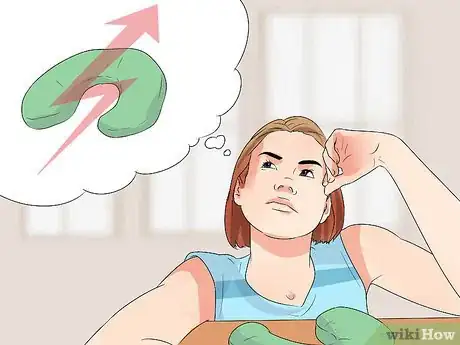
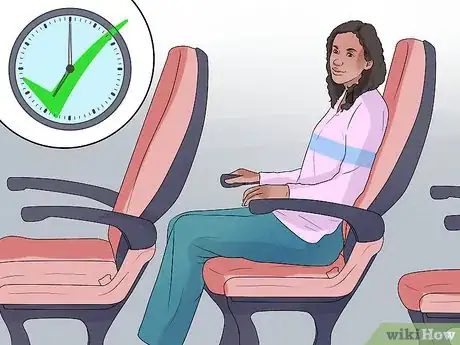
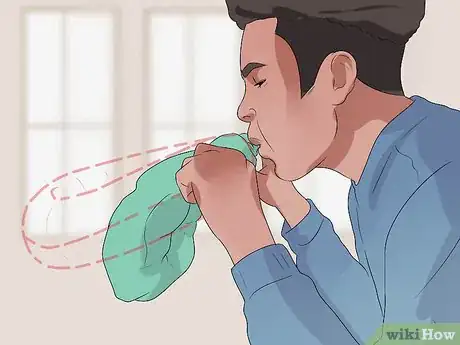
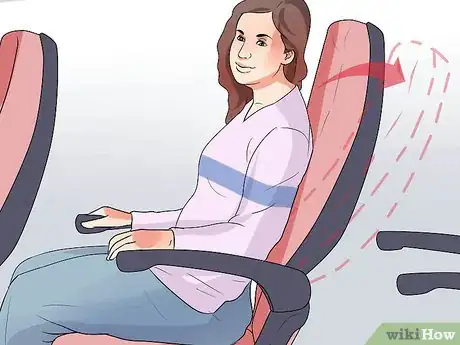

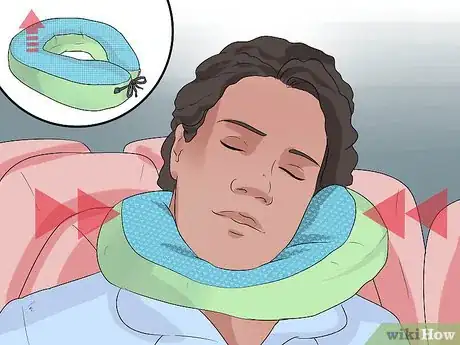

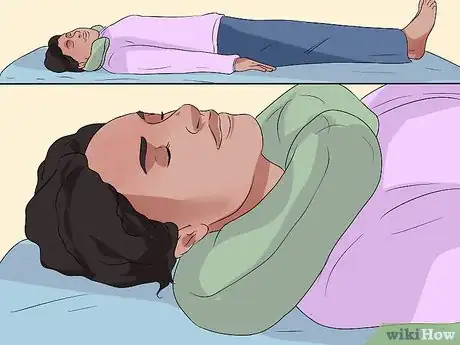


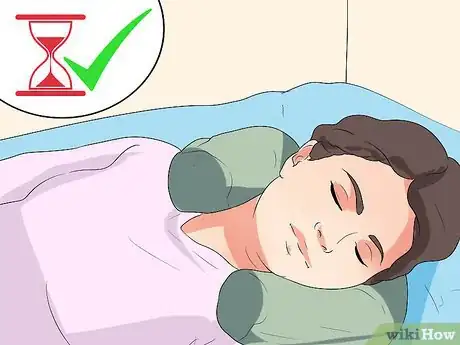

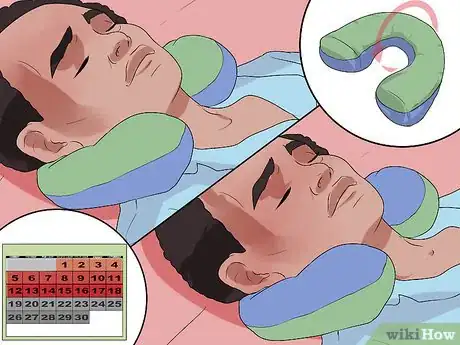



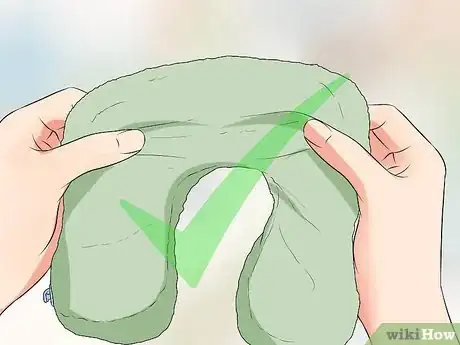










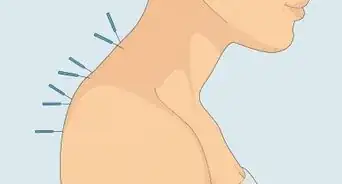
-Step-3-Version-3.webp)


















































